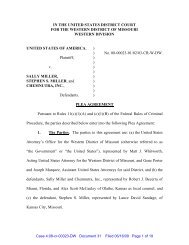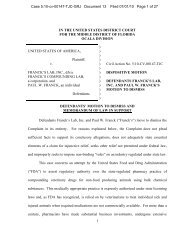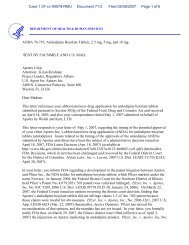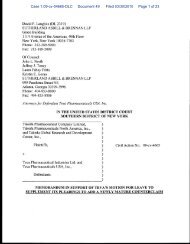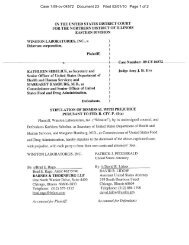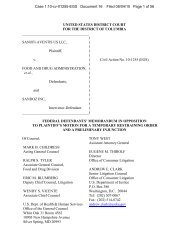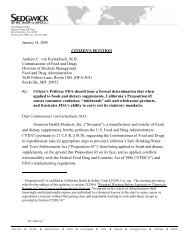- Page 5: RXD AND DRUG ACMINISTRATIONAPProVED
- Page 9: approved application, a list of app
- Page 12 and 13: products that have been approved" i
- Page 14 and 15: To assist the user in relating the
- Page 16 and 17: an evaluatien of therapeutic equiva
- Page 18 and 19: ioavailability data is required for
- Page 22 and 23: and the rate of absorption.pharmace
- Page 24 and 25: 4. Erythromycin stearate Tablets -
- Page 27 and 28: II. LISTINGSA. FORMAT GUIDEThis p..
- Page 29 and 30: CURRENT STATUS - POSSIBLY EFFECTIVE
- Page 31 and 32: DRUG ProDUCT EKAMPLESSingle Ingredi
- Page 33 and 34: APPROVED PRESCRIPTION DRUG PRODUCTS
- Page 35 and 36: APPROVED PRESCRIPTION DRUG PRODUCTS
- Page 37 and 38: APPROVED PRESCRIPTION DRUG PRODUCTS
- Page 39 and 40: APPROVED PRESCRIPTION DRUG PRODUCTS
- Page 41 and 42: APPROVED PRESCRIPTION DRUG PRODUCTS
- Page 43 and 44: APPROVED PRESCRIPTION DRUG PRODUCTS
- Page 45 and 46: APPROVED PRESCRIPTION DRUG PRODUCTS
- Page 47 and 48: APPROVED PRESCRIPTION DRUG PRODUCTS
- Page 49 and 50: APPROVED PRESCRIPTION DRUG PRODUCTS
- Page 51 and 52: APPROVED PRESCRIPTION DRUG PRODUCTS
- Page 53 and 54: APPROVED PRESCRIPTION DRUG PRODUCTS
- Page 55 and 56: j./APPROVED PRESCRIPTION DRUG PRODU
- Page 57 and 58: APPROVED PRESCRIPTION DRUG PRODUCTS
- Page 59 and 60: APPROVED PRESCRIPTION DRUG PRODUCTS
- Page 61 and 62: APPROVED PRESCRIPTION DRUG PRODUCTS
- Page 63 and 64: APPROVED PRESCRIPTION DRUG PRODUCTS
- Page 65 and 66: -,----APPROVED PRESCRIPTION DRUG PR
- Page 67 and 68: APPROVED PRESCRI~TIOHDRUG PRODUCTSD
- Page 69 and 70: APPROVED PRESCRIPTION DRUG PRODUCTS
- Page 71 and 72:
APPROVED PRESCRIPTION DRUG PRODUCTS
- Page 73 and 74:
APPROVED PRESCRIPTION DRUG PRODUCTS
- Page 75 and 76:
APPROVED PRESCRIPTION DRUG PRODUCTS
- Page 77 and 78:
DIMENHYDlHNATEAPPROVED PRESCRIPTION
- Page 79 and 80:
APPROVED PRESCRIPTION DRUG PRODUCTS
- Page 81 and 82:
------"".,APPROVED PRESCRIPTION DRU
- Page 83 and 84:
APPROVED PRESCRIPTION DRUG PRODUCTS
- Page 85 and 86:
APPROVED PRESCRIPTION DRUG PRODUCTS
- Page 87 and 88:
APPROVED PRESCRIPTION DRUG PRODUCTS
- Page 89 and 90:
APPROVED PRESCRIPTION DRUG PRODUCTS
- Page 91 and 92:
APPROVED ¥RESCRIPTION DRUG PRODUCT
- Page 93 and 94:
APPROVED PRESCRIPTION DRUG PRODUCTS
- Page 95 and 96:
'''"APPROVED PRESCRIPTION DRUG PROD
- Page 97 and 98:
----..//APPROVED PRESCRIPTION DRUG
- Page 99 and 100:
APPROVED PRESCRIPTION DRUG PRODUCTS
- Page 101 and 102:
APPROVED PRESCRIPTION DRUG PRODUCTS
- Page 103 and 104:
APPROVED PRESCRIPTION DRUG PRODUCTS
- Page 105 and 106:
APPROVED PRESCRIPTION DRUG PRODUCTS
- Page 107 and 108:
APPROVED PRESCRIPTION DRUG PRODUCTS
- Page 109 and 110:
APPROVED PRESCRIPTION DRUG PRODUCTS
- Page 111 and 112:
APPROVED PRESCRIPTION DRUG PRODUCTS
- Page 113 and 114:
APPROVED PRESCRIPTION DRUG PRODUCTS
- Page 115 and 116:
APPROVED PRESCRIPTION DRUG PRODUCTS
- Page 117 and 118:
APPROVED PRESCRIPTION DRUG PRODUCTS
- Page 119 and 120:
APPROVED PRESCRIPTION DRUG PRODUCTS
- Page 121 and 122:
APPROVED PRESCRIPTION DRUG PRODUCTS
- Page 123 and 124:
APPROVED PRESCRIPTION DRUG PRODUCTS
- Page 125 and 126:
"~''''''-- .APPROVED PRESCRIPTION D
- Page 127 and 128:
APPROVED PRESCRIPTION DRUG PRODUCTS
- Page 129 and 130:
APPROVED PRESCRIPTION DRUG PRODUCTS
- Page 131 and 132:
APPROVED PRESCRIPTION DRUG PRODUCTS
- Page 133 and 134:
APPROVED PRESCRIPTION DRUG PRODUCTS
- Page 135 and 136:
APPROVED PRESCRIPTION DRUG PRODUCTS
- Page 137 and 138:
APPROVED PRESCRIPTION DRUG PRODUCTS
- Page 139 and 140:
APPROVED PRESCRIPTION DRUG PRODUCTS
- Page 141 and 142:
APPROVED PRESCRIPTION DRUG PRODUCTS
- Page 143 and 144:
APPROVED PRESCRIPTION DRUG PRODUCTS
- Page 145 and 146:
APPROVED PRESCRIPTION DRUG PRODUCTS
- Page 147 and 148:
APPROVED PRESCRIPTION DRUG PRODUCTS
- Page 149 and 150:
APPROVED PRESCRIPTION DRUG PRODUCTS
- Page 151 and 152:
APPROVED PRESCRIPTION DRUG PRODUCTS
- Page 153 and 154:
APPROVED PRESCRIPTION DRUG PRODUCTS
- Page 155 and 156:
APPROVED PRESCRIPTION DRUG PRODUCTS
- Page 157 and 158:
APPROVED PRESCRIPTION DRUG PRODUCTS
- Page 159 and 160:
APPROVED PRESCRIPTION DRUG PRODUCTS
- Page 161 and 162:
APPROVED PRESCRIPTION DRUG PRODUCTS
- Page 163 and 164:
APPROVED PRESCRIPTION DRUG PRODUCTS
- Page 165 and 166:
APPROVED PRESCRIPTION DRUG PRODUCTS
- Page 167 and 168:
APPROVED PRESCRIPTION DRUG PRODUCTS
- Page 169 and 170:
APPROVED PRESCRIPTION DRUG PRODUCTS
- Page 171 and 172:
APPROVED PRESCRIPTION DRUG PRODUCTS
- Page 173 and 174:
APPROVED PRESCRIPTION DRUG PRODUCTS
- Page 175 and 176:
APPROVED PRESCRIPTION DRUG PRODUCTS
- Page 177 and 178:
APPROVED PRESCRIPTION DRUG PRODUCTS
- Page 179 and 180:
APPROVED PRESCRIPTION DRUG PRODUCTS
- Page 181 and 182:
APPROVED PRESCRIPTION DRUG PRODUCTS
- Page 183 and 184:
APPROVED PRESCRIPTION DRUG PRODUCTS
- Page 185 and 186:
APPROVED PRESCRIPTION DRUG PRODUCTS
- Page 187 and 188:
APPROVED PRESCRIPTION DRUG PRODUCTS
- Page 189 and 190:
PERCORTEN PIVALATE, DESOXYCORTICOST
- Page 191 and 192:
APPROVED PRESCRIPTION DRUG PRODUCTS
- Page 193 and 194:
APPROVED PRESCRIPTION DRUG PRODUCTS
- Page 195:
oAPPROVED PRESCRIPTION DRUG PRODUCT
- Page 198 and 199:
APPROVED PRESCRIPTION DRUG PRODUCTS
- Page 200 and 201:
APPROVED PRESCRIPTION DRUG PRODUCTS
- Page 202 and 203:
APPROVED PRESCRIPTION DRUG PRODUCTS
- Page 204 and 205:
APPROVED PRESCRIPTION DRUG PRODUCTS
- Page 206 and 207:
APPROVED PRESCRIPTION DRUG PRODUCTS
- Page 208 and 209:
APPROVED PRESCRIPTION DRUG PRODUCTS
- Page 210 and 211:
APPROVED PRESCRIPTION DRUG PRODUCTS
- Page 212 and 213:
APPROVED PRESCRIPTION DRUG PRODUCTS
- Page 214 and 215:
APPROVED PRESCRIPTION DRUG PRODUCTS
- Page 216 and 217:
APPROVED PRESCRIPTION DRUG PRODUCTS
- Page 218 and 219:
APPROVED PRESCRIPTION DRUG PRODUCTS
- Page 220 and 221:
APPROVED PRESCRIPTION DRUG PRODUCTS
- Page 222 and 223:
APPROVED PRESCRIPTION DRUG PRODUCTS
- Page 224 and 225:
APPROVED PRESCRIPTIOH DRUG PRODUCTS
- Page 226 and 227:
APPROVED PRESCRIPTION DRUG PRODUCTS
- Page 228 and 229:
APPROVED PRESCRIPTION DRUG PRODUCTS
- Page 230 and 231:
APPROVED PRESCRIPTION DRUG PRODUCTS
- Page 232 and 233:
APPROVED PRESCRIPTION DRUG PRODUCTS
- Page 234 and 235:
APPROVED PRESCRIPTION DRUG PRODUCTS
- Page 237 and 238:
APPROVED PRESCRIPTION DRUG PRODUCTS
- Page 239 and 240:
APPROVED PRESCRIPTION DRUG PRODUCTS
- Page 241 and 242:
APPROVED PRESCRIPTION DRUG PRODUCTS
- Page 243:
APPROVED PRESCRIPTION DRUG PRODUCTS
- Page 246 and 247:
PRESCRIPTION DRUG PRODUCTS DEEMED A
- Page 248 and 249:
PRESCRIPTION DRUG PRODUCTS DEEMED A
- Page 250 and 251:
PRESCRIPTION DRUG PRODUCTS DEEMED A



